
In 1939 I
worked for a very large firm, STC (Standard Telephones & Cable Co.) where most
men between 18 and 20 years of age were being called up for the Army.
It seemed the more experienced men between 20 and 30 were reserved for a
while. I was lucky.
I got into the Navy on 12 February 1941 being 18 years and three months
old. I went to Chatham where I did a trade test to become an
electrical rating. The test
consisted of cable-jointing (married joints) with a plumbed lead sheath, wiring
a mock-up panel and fault-finding on another panel.
Fortunately I passed. If I
hadn't, I would have been made a seaman or a stoker (a terrible thought).
I then had a three-month training course consisting of rifle drills,
marching, seamanship, knots and ships' electrics
There were
about 40 men in my class and, on completion of the course, an old Chief Petty
Officer (well, old to me then - about 60) separated us into two groups.
He then said to one group, "You will be General Service, i.e. anything
from frigates to battleships with
Chatham as your home port."
He then said to my group, "You will go to the Royal Naval Patrol Service
(RNPS) based at Lowestoft, mainly for minesweepers."
I asked him, "Is that good, Chief?"
He replied, "You won't effing last long!"
I arrived at Lowestoft and was
billeted in a private house, as most of us were, to await a draft.
After two weeks, I was sent to a sweeper (Motor Minesweeper MMS 41) in
Lowestoft docks which was fortunate as I didn't have a train journey to
somewhere around Britain
to pick up a ship. I had about two
hours tuition with an electrics officer on how to operate and control the
magnetic sweeping gear and the acoustic hammer.
The next day we were off into the North Sea
to sweep our way to Sheerness accompanied by a partner ship.
Somewhere off Harwich we blew up our first mine and the crew gave me a
big cheer. We were based at a small
port, Queenborough (Minesweeping HQ & depot ship HMS St Tudno), which is about
two miles up the River Medway from Sheerness.
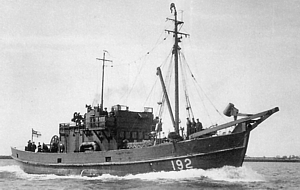
Motor Minesweeper similar to MMS 41 showing 'Kango'
(SA acoustic hammer) in raised position over bow
We worked out of Queenborough for 18 months, generally doing four
days out and two in, which consisted of up to Harwich and back, and round to
Dover and back. At Queenborough
there was a shore maintenance base, a NAAFI and a beer canteen one could use in
the evening. We purchased most of
our food at the NAAFI as we got an allowance of two shillings per day to do our
own catering. I took on the job of
catering as the cook was not interested in buying the food; only cooking it and
this he hated.
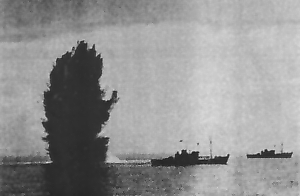
Mine explosion from Ernest's ship (MMS 41)
During that spell at Queenborough, we destroyed a large number of
mines [over a hundred] but even so a number of merchant ships was sunk, especially in the Thames
Estuary. You couldn't get them all.
Also during that spell at Queenborough I was honoured with a bronze oak
leaf (Mention in Despatches) for the following incident.
Invariably when a mine was triggered, it blew up either side of the towed
cable but one evening while coming down the east coast, we got one immediately
under the cable. I was on deck at
the time and I saw the cable loop up into the air with the column of water that
occurs when you blow a mine. The
Chief Engineer called me to get down in the engine room and look at my control
panel because he thought that there was something unusual on the ammeter.
There certainly was. It was
reading over 4,000 amps instead of the normal 3,000 amps.
It was then obvious that the cable had been stripped of its insulation
causing a short circuit. I reported to the Skipper that we
had damaged the cable with our last mine so we couldn't continue sweeping.
He said that it was out of the question to pack up as there was a convoy
due in a few hours time. I told him
that I hadn’t got the jointing equipment - very large brass lugs and sweating
gear like they use at the shore maintenance base - but I was willing to have a
go at doing a joint by hand, to which he agreed. The cable
was pulled aboard until we got to the damaged section, and there was about two
hours of daylight left in which I thought I could just about manage. I
cut the cable completely through and stripped back the insulation about four
feet along each piece. I then
proceeded to do a married joint of about 300 strands of wire.
After
about two hours I was nowhere near finished so the seamen rigged up a sailcloth
cover with a light inside for me to carry on.
I continued and finally finished the intertwining of hundreds of strands;
for good measure I fitted four jubilee clips.
Then finally I wrapped the whole length of the bare joint with yards and
yards of pure rubber and covered it completely with linen tape, then applied
heat with a blowlamp to vulcanise the rubber. When the
linen tap showed scorching you knew that the rubber underneath had vulcanised,
i.e. moulded into one thick layer.
The cable
was put back into the sea after three hours, all switched on and working again.
The remarkable thing is that we had only gone about three miles before we
blew up a mine. The Skipper was
thrilled to bits. Apparently he got
in touch with the commander of that following convoy the next day and told him
what had happened. We assume it was
that commander who got in touch with the Admiralty to recommend some recognition
for me. In due course I received a
‘Mentioned in Despatches’ bronze oak leaf.
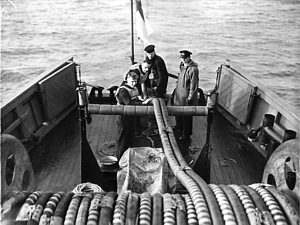
LL Magnetic Sweep being streamed
from a Motor Minesweeper
[By Webmaster: Readers may also be interested in
this
article on the BBC website about the late Lt Cdr Eric Garside DSC VRD RNVR,
the first Commanding Officer of MMS 41.]
In December
1942 I was called back to Lowestoft
and was given a draft to ‘somewhere abroad’ (they wouldn’t tell you where).
I picked up a troopship, the P&O liner Stratheden, which left Gourock in
Scotland
carrying 4,000
soldiers and just about 100 sailors (about four sweeper crews).
Our first stop was Durban, South Africa
then finally Bombay in India.
After a couple of weeks in Bombay
we had a very long train journey to
Karachi
where we commissioned our sweepers.
I served in the converted Norwegian whaler Shooting Star [ex-Vestfjord
VI].
From there, we had a long sail to Colombo in Ceylon
where we were based for nearly two years, sweeping the Indian Ocean down as far
as the Maldives.
Then we spent a few months around Madras and Calcutta up the
east coast of India.
I often saw troopships and landing craft heading for
Rangoon, etc.
Poor souls, I thought.
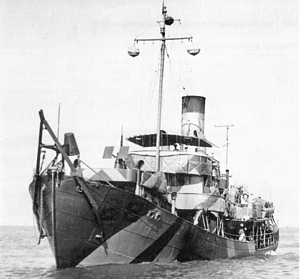
Ex-Norwegian whaler minesweeper similar to
Shooting Star.
(Note 'Kango' SA acoustic hammer in raised position over bow)
Eventually we were sent back to
Colombo
for a ship home. The ship was the
light cruiser HMS Enterprise. What
a shock to the system that was, especially after a minesweeper with a crew of
about 20. There must have been
something like 800 crew on board, and we had to dress and act like proper
sailors. We finally landed at
Portsmouth, the ship’s home port, and I was transferred to my own
headquarters at Lowestoft.
From there I got a draft to the Steam Gunboat HMS Grey Goose (SGB 9))
based at Oban in Scotland.
Peter Scott was superseded as her CO just as I arrived.
[By Webmaster: In 1944, the Steam Gunboats
were converted as fast minesweepers. They were all sold
soon after the war except Grey Goose
which remained in service as a trials vessel until sold in
the late 1950s.
Lt Cdr Peter Scott RN was the son of Scott of the Antarctic (Captain Robert
Falcon Scott Royal Navy) and later became Sir Peter Scott, the famous
broadcaster, naturalist and painter.]
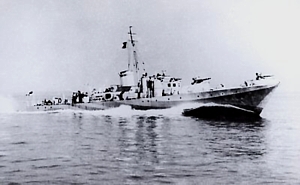
HMS Grey Goose (SGB 9)
In May
1946 I was finally sent back to Lowestoft for
demob. I was kitted out with a
suit, overcoat, shoes, socks and a pair of braces, then home sweet home.
That is how I won the war; well, I’ll admit I was helped by Admiral
Mountbatten and Field Marshall Montgomery.
Leading
Wireman E A Goodhall
P.S. I did actually meet Mountbatten and held his heavily
gold-braided cap when he gave us a pep talk in a shed in
Colombo.
Sweeping Procedure
Once under way and the Skipper had given the order ‘Out Sweep’, four
seamen would lower the cable into the sea over rollers at the stern while I got
the 54kW generator running and set charging the batteries at 200 amps.
When the cable was fully streamed, all 547 yards of it, this left me to
connect the very large brass cable lugs to terminals in a steel connection box
aft. Once this was done, the next part of the procedure
was to switch on the Venner Time Control in the wheelhouse.
It wasn’t quite as straightforward as that because you had to get
synchronised with your partner ship so that both ships were sending out the
magnetic field of the same polarity.
Before we left harbour, my opposite number in the partner ship and I
would agree on who would do the synchronising.
Let’s say it was me to do this.
I would signal the partner to switch on and start pulsing.
Their pulse indication lights would come on for five seconds in every 30
seconds; one light at the forward location meant that they were putting a
positive feed out through the short leg which produced a north magnetic field
between the ships. Their next pulse
would show me two lights; one at the forward location and one aft, indicating a
change of polarity. Now I had to watch very carefully for
when their single light came on, i.e. forward location, and when it went off.
When it went off I would immediately switch on the Venner time clock
again. Then both ships should have
been synchronised but sometimes I may have been a bit slow on switching on again
and perhaps lost a second. If this
happened, I had to got through the operation again until I got it spot on.
The system then carried on for the rest of the sweeping session.
With regard to acoustic sweeping (this was for mines that went off
from the noise of a ship’s engine), the
large bucket-like steel container housing the ‘Kango’ was lowered over the bow
on an ‘A’ frame and made fast with steel cables.
This was carried out prior to launching the magnetic minesweeping cable.
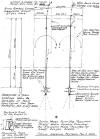
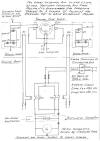
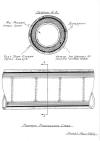
Supporting Diagrams
[Postscript: Sadly, Ernest died peacefully
in his garden on 28 May 2009, just over a year after sending these memories.]
Back
to Dit Box
Home

